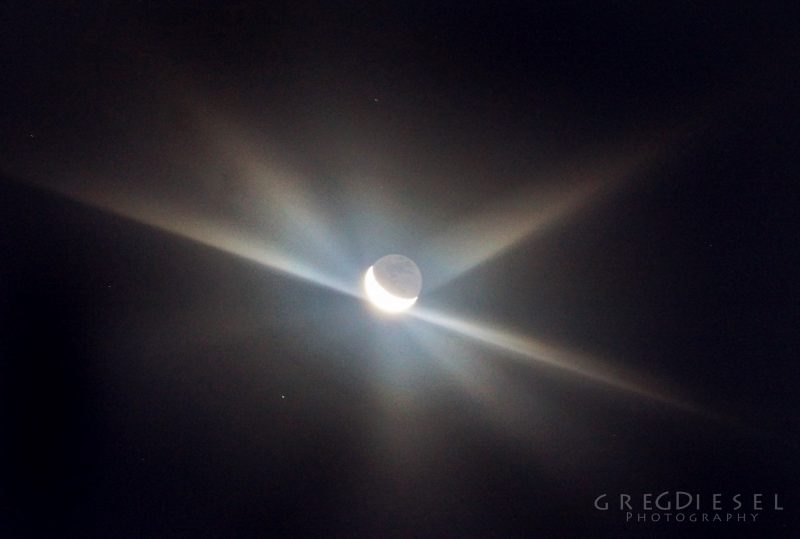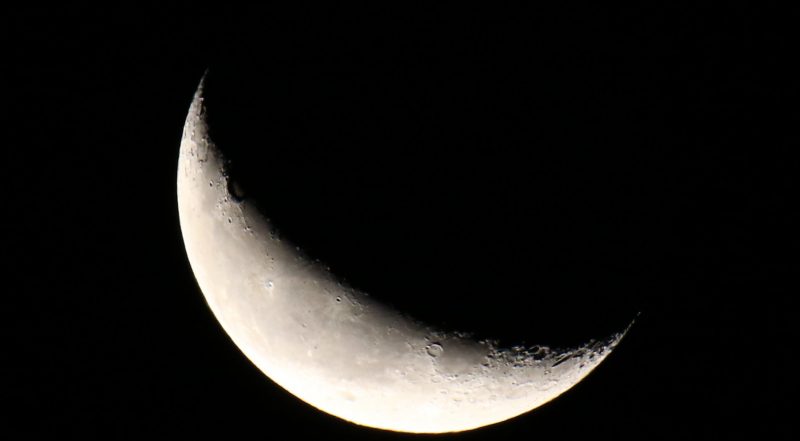

Here’s a waning crescent moon – 27% illuminated, with earthshine – and showing a humidity-induced lens flare. Photo by Greg Diesel Walck – Lunar/Landscape Photographer.
In the week following last quarter moon, the moon continues to wane. You’ll see it as a waning crescent moon – sometimes called an old moon – visible in the east before dawn.
Each morning, the moon shows us less and less of its lighted side. It rises closer to the sunrise, heading for new moon.
Want to know a sky trick? The illuminated side of a waning crescent moon always points eastward, or in the direction of sunrise.
Moreover, the lit side of waning crescent points in the direction of the moon’s daily motion relative to the backdrop stars and planets of the zodiac. That direction is also east.
Many people miss the waning crescent moon because it’s a morning moon, visible before sunrise. But it’s fun to follow the waning crescent day by day, as it inches into the dawn glare.
As the moon orbits Earth, it changes phase in an orderly way. Follow the links below to understand the phases of the moon.
New moon
Waxing crescent moon
First quarter moon
Waxing gibbous moon
Full moon
Waning gibbous moon
Last quarter moon
Waning crescent moon
Read more: 4 keys to understanding moon phases
Bottom line: A waning crescent moon comes between last quarter moon and new moon.
Check out EarthSky’s guide to the bright planets.
Help EarthSky keep going! Please donate.
from EarthSky https://ift.tt/2DOsEBQ


Here’s a waning crescent moon – 27% illuminated, with earthshine – and showing a humidity-induced lens flare. Photo by Greg Diesel Walck – Lunar/Landscape Photographer.
In the week following last quarter moon, the moon continues to wane. You’ll see it as a waning crescent moon – sometimes called an old moon – visible in the east before dawn.
Each morning, the moon shows us less and less of its lighted side. It rises closer to the sunrise, heading for new moon.
Want to know a sky trick? The illuminated side of a waning crescent moon always points eastward, or in the direction of sunrise.
Moreover, the lit side of waning crescent points in the direction of the moon’s daily motion relative to the backdrop stars and planets of the zodiac. That direction is also east.
Many people miss the waning crescent moon because it’s a morning moon, visible before sunrise. But it’s fun to follow the waning crescent day by day, as it inches into the dawn glare.
As the moon orbits Earth, it changes phase in an orderly way. Follow the links below to understand the phases of the moon.
New moon
Waxing crescent moon
First quarter moon
Waxing gibbous moon
Full moon
Waning gibbous moon
Last quarter moon
Waning crescent moon
Read more: 4 keys to understanding moon phases
Bottom line: A waning crescent moon comes between last quarter moon and new moon.
Check out EarthSky’s guide to the bright planets.
Help EarthSky keep going! Please donate.
from EarthSky https://ift.tt/2DOsEBQ


Aucun commentaire:
Enregistrer un commentaire